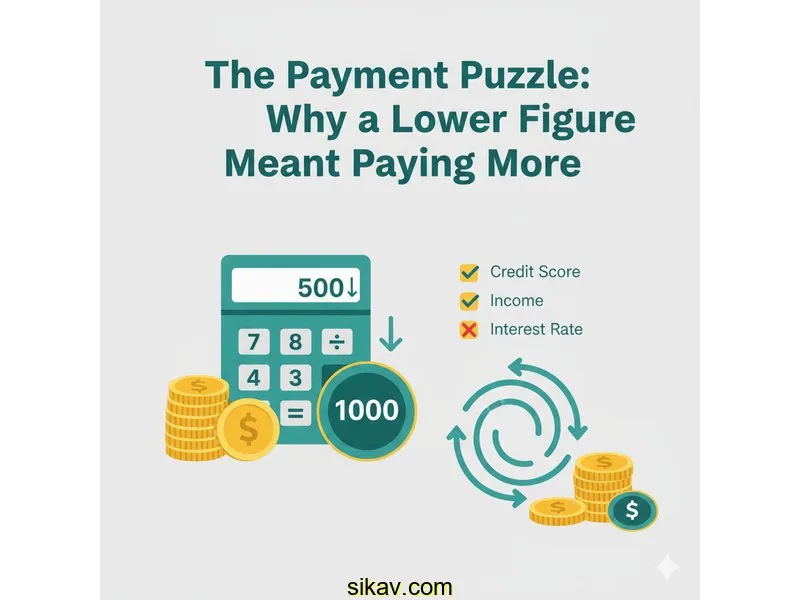
Auto Loan Calculator
Calculate payments over the life of your Loan
Home Blog Privacy Terms About Contact
Calculate payments over the life of your Loan
Home Blog Privacy Terms About ContactPublished on October 15, 2025

My journey into the world of loan calculations started not with a spreadsheet or a textbook, but with a simple conversation over coffee. A friend was talking about a personal loan they had, and they casually mentioned their monthly payment. I was surprised. The amount was comfortably low, especially considering the loan principal was similar to a figure I had been thinking about for a home improvement project.
My mind immediately jumped to a conclusion: "They must have found an amazing interest rate!" I became a little obsessed with this idea. How could I find a loan with a monthly payment that low? It seemed like the single most important number, the one that would determine affordability and signal a "good deal." That single data point from my friend's experience set me off on a quest, but not the one I was expecting.
My initial goal was simple: use online loan calculators to replicate that low monthly payment for my own scenario. I figured it was just a matter of punching in numbers until I hit that magic, low figure. What does it take to get a payment under a certain threshold? How much does the interest rate have to drop to make that happen? These were the questions I thought I needed to answer.
But as I started plugging numbers into various online tools, something felt off. The outputs were confusing, and the relationship between the different figures wasn't intuitive. I was so focused on shrinking one number—the monthly payment—that I was completely blind to what the other numbers were trying to tell me. This is the story of how I learned that two numbers, the monthly payment and the total outlay, can tell two very different stories. This is about understanding how calculations work, not financial advice.

Armed with my goal, I found a standard loan calculator online and got to work. My target was to understand how to achieve a low monthly payment, just like my friend. I decided to set up a hypothetical scenario to see the mechanics in action. I keyed in a loan amount of $14,850, a figure I was using for my project research.
I started by plugging in numbers that seemed similar to what my friend might have. Let's say, a 60-month term. I entered an interest rate of 7.2%. The calculator instantly produced a result: a monthly payment of around $294.04. "There it is!" I thought. That number looked manageable, comfortable, and very appealing. It felt like a success.
Then, just to see what would happen, I decided to try a shorter term. What if I tried to be more aggressive and pay it off sooner? I kept the loan amount at $14,850 and the interest rate at 7.2%, but I changed the term to 48 months. The new monthly payment popped up: $356.55. My immediate, gut reaction was one of rejection. "That's over $60 more a month. The first option is clearly better," I concluded. My entire focus was on that single field. The lower number felt like the winner, end of story.
The online calculator displayed other information, of course. There were fields labeled "Total Principal Paid," "Total Interest Paid," and "Total of Payments." I saw them, but I didn't truly see them. My eyes glazed over these details because they didn't seem relevant to my quest for the lowest possible monthly payment. My thinking was completely one-dimensional: lower monthly payment equals a better situation. The frustration began to build when I realized I couldn't explain *why* the numbers changed the way they did, beyond the obvious fact that a shorter term means higher payments.
The turning point came when I stopped trying to win a game of "get the lowest monthly payment." I was so fixated on that one output that I was ignoring the entire story the calculator was trying to tell me. I took a breath, leaned back, and decided to look at every single number on the screen for both scenarios, side-by-side. My curiosity shifted from "How can I make this number smaller?" to "Why are these numbers so different?"
It was this deliberate shift in perspective that led to my "aha" moment. I wasn't just looking at a payment; I was looking at a complete system where changing one part, like the loan term, created ripples across all the other parts. I decided to map out exactly what I was misunderstanding versus what the calculator was actually showing me. This process of breaking it down, element by element, was what finally made the connection click.
My first real step to understanding was to conduct a controlled test. I used the calculator as my lab. I fixed the loan principal ($14,850) and the interest rate (7.2%). The only variable I changed was the loan term. This allowed me to see, with perfect clarity, how the duration of the loan was the true lever controlling both the monthly payment and the total interest.
The next step was doing the math myself to build my confidence. I took the lower monthly payment, $294.04, and multiplied it by its term of 60 months. The result was $17,642.40. When I subtracted the original loan amount of $14,850, I was left with $2,792.40. It matched the "Total Interest Paid" field exactly. I repeated this for the 48-month option: $356.55 multiplied by 48 equals $17,114.40. The interest was $2,264.40. The numbers weren't magic anymore; they were just arithmetic.
This simple exercise made me see the fundamental trade-off. A longer term spreads the principal repayment over more months, which naturally lowers the payment. However, it also means the outstanding balance remains higher for longer, giving interest more time to accumulate on that balance. I was essentially paying for the convenience of a lower monthly payment with over $500 in additional interest.
To really drive the point home, I ran the same $14,850 loan at 7.2% for a 36-month term. The payment jumped to $463.09, which seemed high. But when I checked the total interest, it was only $1,821.24. The pattern was undeniable. The shorter the term, the higher the monthly payment, but the lower the total amount of interest paid over the life of the loan.
This whole experience completely reshaped how I interact with loan calculators and interpret financial numbers. My focus shifted from hunting for a single "best" number to understanding the relationship between all the numbers. It was a lesson in financial literacy that went far beyond my initial, simple question. Here are the key things I now understand about the calculations.
Throughout my learning process, I had a lot of questions. Here are a few that I had to work through to really solidify my understanding, framed in an educational context.
Interest is calculated on the outstanding balance of your loan. With a longer term, your principal balance decreases more slowly. This means that for a greater number of months, you are paying interest on a larger outstanding balance. Even though the interest rate is the same, this extended period of accumulation results in a higher total interest figure over the life of the loan.
The link is the loan term. The basic formula is: (Monthly Payment × Number of Months) - Original Loan Principal = Total Interest Paid. This shows that the total amount you pay is a direct function of that monthly payment figure and the duration. A small reduction in your monthly payment, if achieved by stretching the term, can lead to a significant increase in the total interest paid because you're multiplying it by a larger number of months.
The best way is to perform a controlled test, just as I did. Enter your desired loan amount and an estimated interest rate. Then, run the calculation for several different terms—for example, 36 months, 48 months, and 60 months. Don't just look at the monthly payment. Write down the "Total Interest Paid" or "Total of Payments" for each scenario. This will give you a clear, side-by-side view of how much each option truly costs in the long run.
No, and this is a crucial distinction. The loan amount (or principal) is the money you originally borrow. The "Total of Payments" is the full amount of money you will have paid back by the end of the loan term. This figure includes the original principal *plus* all the interest accrued over the life of the loan.
My biggest takeaway from this entire journey is that numbers tell a story, but you have to read the whole page, not just the headline. I started out chasing a single number—a low monthly payment—believing it was the hero of the story. I ended up learning that the real narrative is about balance and understanding the full picture.
The most comfortable monthly payment isn't always the one that leads to the lowest overall outlay. There is no universally "better" option; there is only a trade-off. Understanding that trade-off is the foundation of financial literacy. Playing with calculators and seeing these numbers change in real-time gave me an intuition for these concepts that reading alone never could.
I encourage anyone who feels intimidated by these calculations to open an online tool and just start experimenting. Change the term. Adjust the rate. See how the outputs dance with each other. It’s not about finding the perfect loan; it’s about understanding the language of loans so you can follow the story they are telling. This article is about understanding calculations and using tools. For financial decisions, always consult a qualified financial professional.
Disclaimer: This article documents my personal journey learning about loan calculations and how to use financial calculators. This is educational content about understanding math and using tools—not financial advice. Actual loan terms, rates, and costs vary based on individual circumstances, creditworthiness, and lender policies. Calculator results are estimates for educational purposes. Always verify calculations with your lender and consult a qualified financial advisor before making any financial decisions.
